Welcome to Jain Irrigation Systems Ltd.

Blog at Jains - STUDIES ON OPTIMIZATION OF FERTIGATION LEVELS TO MAXIMIZE THE VIGOUR AND RHIZOME YIELD OF TURMERIC VARIETIES
Abstract: Turmeric varieties are grown with drip irrigation and fertigation. First, it was found that there is variability in the vigor and yield expression in Turmeric when irrigated and fertigated with drip. In subsequent years (2016 and 2017) two varieties, BSR –2 and Salem local were grown with 3 different levels of fertigation, 75%, 100% and 125% of recommended dose (RDF) of NPK. In both years it was found that Salem local is a better performer and 125% RDF is supporting the highest yield of the crop of both varieties. Of the varieties, Salem local seems to be superior in its response to fertigation. Drip fertigation enhances water and fertilizer use efficiencies and supports efficient precision farming.
Citation: Soman P., et al., (2019) Studies on Optimization of Fertigation Levels to Maximize the Vigour and Rhizome Yield of Turmeric Varieties. International Journal of
Agriculture Sciences, ISSN: 0975–3710 & E–ISSN: 0975–9107, Volume 11, Issue 16, pp.– 8891–8894.
Copyright: Copyright©2019 Soman P., et al., This is an open–access article distributed under the terms of the Creative Commons Attribution License, which permits
unrestricted use, distribution and reproduction in any medium, provided the original author and source are credited.
Academic Editor / Reviewer: Seyyed Fazel Fazeli Kakhki
Introduction
Turmeric is a very important ancient and sacred spice of India, used as condiment, a dye and as an aromatic stimulant in several medicines. Turmeric (Curcuma longa L), belonging to the family Zingiberaceae, is a rhizomatous, herbaceous plant, native to Indian sub–continent. It is used in India since time immemorial, as a spice in culinary preparations. Rhizomes are used fresh or boiled in water and dried, ground into deep orange yellow powder, commonly used in coloring and as a flavoring agent, one of the key ingredients in many Asian cuisines, curries, dishes as well as used as dye. Turmeric powder imparts a warm, bitter flavor, earthy mustard like aroma, when used in culinary dishes. Its use in Ayurveda, Siddha, Chinese and Unani medicine systems is well documented. It is believed to prevent heart disease, Alzheimer and a powerful antioxidant curbing the growth of free–radicals; used as anti –inflammatory, antiseptic .Its regular use as a cosmetic by women helps to keep the skin healthy and glowing; It finds its place in religious offerings ,auspicious ceremonial occasions, as kum kum a by–product. The bright, yellow color of turmeric is due to curcumin, a phytopolyphenol pigment, also contains an orange colored volatile oil. It is mixed into topical cosmetics and creams, herbal soaps, also used as sun burn remedy. With increased awareness on the benefits of turmeric among its users and its use in number of processed products, the demand for turmeric is increasing both in the domestic and international markets. India is the largest producer and exporter of turmeric. The area under turmeric is more than two lakh hectares and the production exceeds 11.5 lakh ton. 80 % of the production is consumed domestically. Telangana, and Andhra Pradesh are the largest producer, followed by Maharashtra, Tamil Nadu, Orissa, West Bengal, Karnataka, Gujarat, Kerala and Sikkim are other states where turmeric is a major crop. Though India leads in production of turmeric, the average productivity is very low due to use of imbalanced, sub–optimal dose of fertilizers [1,2]. Turmeric is a perennial, herbaceous plant, grows more than 1–1.5– meter height, with highly branched, yellow to orange, cylindrical, aromatic rhizomes, leaves alternate, arranged in two rows. Leaves are with leaf sheaths and from the leaf sheaths, false stem (rhizome) is formed. Curcumin (diferuloylmethane) constitute up to 3–4 % of turmeric powder, with a variety of pharmacological properties.
Turmeric, a cash crop, requires comparatively less water, low technology, and less capital investment. The incidence of pest and diseases is minimal and manageable. The processing requirement is simple and can be done within the farm by the farmer with the use of simple machinery and equipment. Processing mainly involves cleaning, grading, boiling the rhizomes and /or slicing and drying in open sunlight. About 20 % of cured, dried rhizome recovered after boiling and drying. Turmeric is mostly sold in dried/cured form, or powdered form. Freshly harvested rhizomes are also traded. There are more than 30 distinct varieties with 7–9 months duration, cultivated in India. They vary in their curcumin content and yield potential. While 80 % turmeric produced in the country is consumed domestically, India is the major exporter, 1,16,500 t /year (2016–17), turmeric is exported to UAE, Saudi Arabia, USA, Japan, Australia, Middle–east, European and Asian countries. Jain Irrigation system has established during 2016, a modern spice processing and blending plant in Jalgaon, Maharashtra, India and is compliant with national and international quality requirements. The unit is equipped with state–of–the–art facilities for cleaning, grading grinding and mixing of spice powders. Improved varieties of turmeric are cultivated in about 80 ha in its captive high–tech farm in Jalgaon, and also at Jains’ R & D farms, Udumalpet, Tamil Nadu.
Extensive studies are done to evaluate high curcumin content varieties for their water and fertilizer requirement, increase in yield potential and improve their quality. It is well recognized that fertigation through drip system is the most efficient means of applying nutrients to the crop. Nutrient elements ratio can be adjusted according to the physiological needs of the crop and its developmental stages. Fertigation ensures that the nutrients are applied precisely, at the zone of intense root activity, according to the specific requirements of turmeric crop, resulting in higher fertilizer–use–efficiency (FUE). Fertigation, generally allows for a significant increase of nutrients– use– efficiency in terms of plant nutrients recovery, with much higher results (upto 90 %) than in other fertilizer application systems (40–45 %) (2). The crop attains maximum vegetative growth during the 5– 6 months, suggesting the need for earlier application of NPK for increasing crop growth [3,4].
Studies on Optimization of Fertigation Levels to Maximize the Vigour and Rhizome Yield of Turmeric Varieties
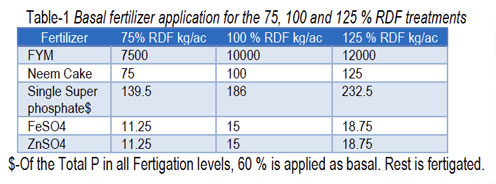
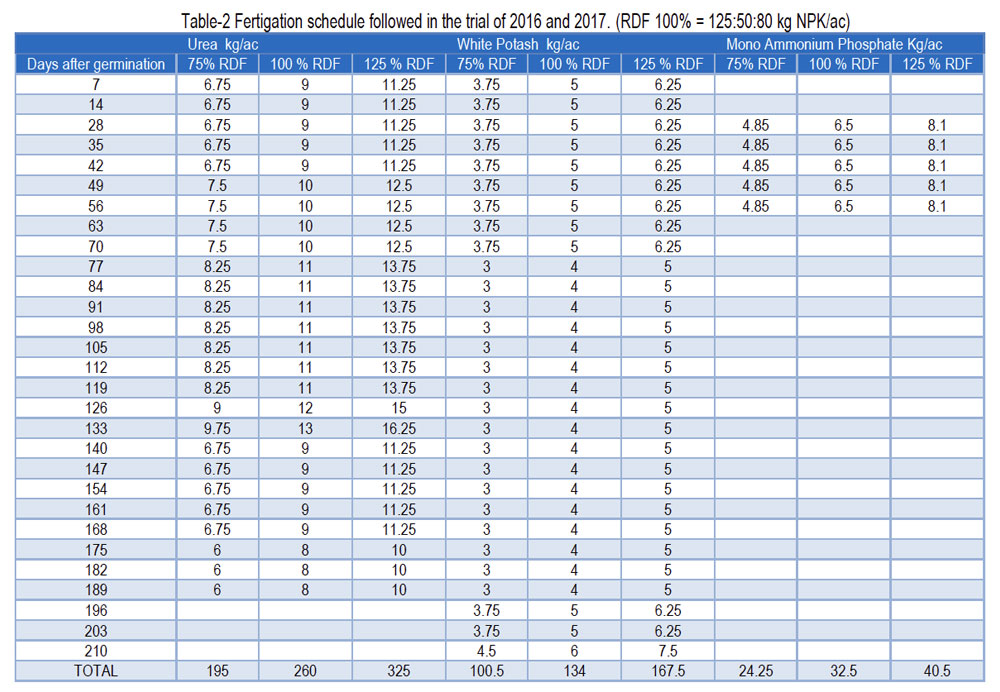
It has been reported that a normal crop of turmeric removes 16.5 kg N, 3.1 kg
P2O5, 44.5 kg K2O per ton of produce and the ratio of K2O and P2O5 removal
related to N works out to 100:19: and 270 respectively (PPIC,2001). Uptake of
nutrients by turmeric at harvest in Kg/ha is reported as shown below [5] .
Place and soil N P K
Bhavanisagar TN 166 37 285
(Sandy loam)
Coimbatore TN 187 38 327
(Clayey loam)
The fertilizer recommendation for turmeric crop in Tamil Nadu is 312 kg N,125 kg
P2O5: 200kg K2O/ha [6].FUE is maximum under drip fertigation. Rajamani, et al.,
[7] in their experiment using three levels of irrigation (80% PE,60 % PE, and 40 %
PE) and three levels of N & K (100 %,75 % and 50 % ) of RDF found that it is
possible to enhance nutrient and water use efficiencies and improve the yield by
adopting fertigation in turmeric. The recommended dose of fertilizers followed in
their studies was 150 :60:108 kg NPK/ha. Sadarunnisa et al[8],studied the effect
of three levels of RDF through three seasons using Cv Mydukur and observed
that 100% RDF through drip recorded maximum plant height (99.36 cm),tillers
(3.41/plant) and rhizome yield 12.4M t/acre (30.2 Mt/ha).This was on par with 75
% RDF treatment. The B;C ratio was highest 1.49 in plants applied with 75 % RDF
through drip indicating 75% RDF was profitable. Velmurugan et al,[9] studied the
influence of organic manures and inorganic fertilizers on cured rhizome yield and
quality of turmeric Cv.BSR–2.The results of two year trial carried out by Rajagopal
Reddy et al,[10], showed that 80 % fertigation met with drip and plastic mulch
resulted in maximum plant height, stem girth, functional leaves, corm weight,
length and yield. Highest yield of 16.64M t/ha was observed at 0.8VDM with 85 %
increase in yield as compared to furrow fertigation. Thyagarajan, et al., [11]
observed that drip irrigation at 80 % and 60 % PE once in two days and fertigation
levels 125,100 and 75 % of RDF of N & K produced higher yields 32.9 to 41.6
Mt/ha during first and second year crop respectively. Satya Reddi and Angadi, [12]
showed that drip irrigated Cv. Cudappah with application of 270:135:180 kg
NPK/ha recorded significantly higher growth and yield attributes and rhizome
yield of 26. 13Mt/ha. The present investigation was carried out to determine the
optimum dose of fertilizers using three different fertigation levels of RDF for getting
the maximum growth and yield of turmeric varieties. This paper presents the
results of first year trial( 2014 –2015)using four varieties of turmeric with RDF
fertigation, the second and third year trial using two varieties with three fertigation
levels of RDF carried out at the Experimental Farm, Udumalpet during 2016 –17
and 2017–18 and the results are discussed.
Materials and Methods
Three years field experiment was conducted to study the effect of differential fertigation levels through drip on the vigour and yield of turmeric varieties during 2015–2018 at Jains R & D farms, Udumalpet, Tamil Nadu, India. The soil of the experimental field was clayey–loam with pH of 7.6, EC. 0.21 dsm–1. Drip laterals of 16 mm diameter were laid at the centre of the bed, 1.2 meter (lateral to lateral) spacing and drippers of 4 LPH were at 60 cm interval along the laterals on raised beds of one meter width plus 0.2 m furrow. In the first year 2014–15, four varieties viz., BSR2, Erode local, Salem local and Duggirala in two replications applying 100 % Recommended dose of fertilizers (RDF) were used. Basal application of farm yard manure, neem cake, SSP and micronutrients Fe, Zn was given [Table–1] besides fertigation from 7th day to 210th day of planting at thirty weekly intervals.
The individual plot size was 216 m2 (one m wide raised bed, X30 m length X 6 beds per variety in two replications; total plot size 1728 m2. In the second and third year statistically designed RBD trial (2016 &2017), two varieties BSR2 and Salem local, receiving three levels of fertigation 75 % RDF,100 % RDF and 125 % RDF [Table–2] replicated three times were used. The individual plot size was 80m2.Total experimental field area was 1440m2. A brief description of the four turmeric varieties used in the experiment are given below.
BSR–2: an induced mutant from Erode–Local, duration of the crop 245 days It is resistant to rhizome scales, Dry rhizomes recovery 20 %, Curcumin content 3.8% potential Yield 32.7 t/ha, plants medium statured, 1m–1.5 m height.
Erode–local: A popular variety in Tamil Nadu, with good market acceptability. Plants are tall, robust, fingers short, slightly bent, with deep orange inner core, with a moderate curing percentage, curcumin 3.9 %, fresh rhizome yield 30–32 M t/ha.
Salem–Local: Farmers prefer Salem local mainly due its suitability to the agroclimatic conditions of TN. Vigorous, tall plants, rhizomes are bigger, fingers longer than Erode local, 4cm long. Its yield comparable to Erode local 30–32Mt/ha, rich in curcumin 4.75 %, moderate in curing percentage, quality excellent, preferred in international market for grinding and blending purpose.
Duggirala: It has larger rhizomes of good quality, more suitable to heavy black soils grown mostly in Krishna, Guntur district, Andhra Pradesh, long duration, 9 months crop, rhizomes bright yellow in color, yield 25 Mt/ha.
All standard cultural practices were followed including mulching, using dried leaves and disease and pest management, good agricultural practices (Jain GAP). For recording biometric observations, five plants were selected at random in each replicate and treatment and the means of each parameter analyzed.
For the first year trial (2014–15) the seed rhizomes and fingers of the four varieties viz:BSR–2,Erode Local, Salem Local and Duggirala were dibbled on the raised bed at 45 cm X 20 cm on June,17,2014.Biometric observations were recorded at physiological maturity (245 days after planting) on February,19,2015.
During 2016–17 &2017–18 the trial on BSR–2 and Salem Local varieties applying three levels of fertigation viz: F1– 75 % RDF, F2– 100 % RDF and F3– 125 % RDF using a randomized block design comprising six treatment combinations and three replications.
The seed rhizomes of BSR–2, and Salem local were dibbled at 45 cm X 20 cm spacing, on raised bed on June 10, 2016 in test plots, with three fertigation treatments, replicated thrice. Total experimental area had been 1440 m2. After 205 days of planting, when the foliage of turmeric plants started withering, fertigation was stopped. Last irrigation was given on the 208th day. After about a month, when the plants completely withered, the raw rhizomes were harvested after wetting the field. The individual plant rhizome and the test plots rhizomes were harvested and weighed according to the treatments. After the harvest of turmeric (2016 planted crop) the field was ploughed well and cover crop of sun hemp was sown and the crop stand was good. Later, the cover crop was ploughed back for preparing the field for the second–year trial.
Results and Discussions
The biometric observations and the yield of rhizome of individual plant, test plot and per ha yield of four varieties, treated with 100 % recommended dose of fertilizers through drip fertigation in two replicates are given in [Table–3]. A careful examination of the results showed that the variety Salem Local recorded maximum vigour in terms of mean plant height (169.35 cm), number of tillers per plant (6.3), mean leaf length (72.37 cm) and leaf width (17.21 cm); also mean yield of single plant rhizome 870 gm and test plot yield 2286 kg followed by Erode Local–2123 kg per plot .Its individual plant rhizome weighed 765 gm.BSR–2 ranked third in yield 1971 kg per plot. Duggirala variety recorded least rhizome weight of test plot, 1785 kg. The yield of the four varieties under study was calculated viz: Salem Local (52.916 t/ha);followed by Erode Local (49.14 t/ha), BSR–2 (45.63 t/ha) and the minimum yield was 41.32 t/ha obtained by the variety Duggirala, indicating that the variety Duggirala’s performance was poor and may not be suitable for Udumalpet, Tamil Nadu climatic and soil conditions while the response to fertigation treatment by Erode Local,BSR–2 and Salem local was comparable.
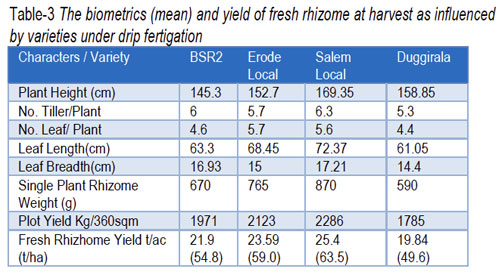
The biometric observations recorded showed the mean vegetative growth parameters of Salem Local was more vigorous in terms of plant height, number of tillers, leaf size, than those of BSR–2. The plants under fertigation treatments showed significant difference for all the vegetative and yield characters studied. The F3, 125 % RDF fertigation recorded more vigorous growth parameters over the other two treatments. Yield under different treatments were presented in [Table–4]. The yield data showed that amongst the two varieties, BSR–2 and Salem Local, the latter recorded highest yield of raw rhizomes of 22.69 t/ac (56.73 t/ha) under 125 % RDF fertigation treatment followed by 100 % RDF, 21.81 t/ac (54.53 t/ha). BSR–2 recorded 19.89 t/ac (49.73 t/ha) under 125 % RDF and 17.95 t/ac (44. 88 t/ha) under 100 % RDF. Under 75 % RDF, the yield was 18.34 t/ac (45.85 t/ha) and 15.66 t/ac (39.15 t/ha) respectively, for Salem Local and BSR–2 thus establishing significantly better performance of Salem local over BSR –2 in terms of yield of raw rhizomes. Amongst the three fertigation treatments, F3, (125 % RDF) recorded 19. 89 t/ac (49.73 t/ha) for BSR–2 and 22.69 t/ac (54.53 t/ha) for Salem Local. The difference in yield between 125 % RDF (F3) and 100% RDF (F2) was too narrow 3.97% (Salem Local) 9.75 % (BSR–2) and not significant, indicating that 100 % RDF (F2) will be more profitable. Salem local under 100 %RDF fertigation treatment significantly a better performer than BSR–2. Among the interactions, the treatment combination of fertigation F 3 (125 % RDF) with Salem Local recorded significantly higher growth and yield 22.69 t/acre (56.73 t/ha) followed by F2 (100 % RDF) 21.81 t /ac (54.53 t/ha).
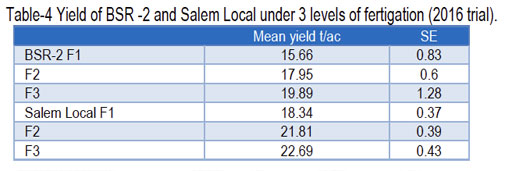
During June 2017–18, the experimental crop was raised exactly same way as it was during 2016–17 using the same two varieties, three fertigation levels of treatment with three replications. Yield of three fertigation treatments of two varieties showed similar trend [Table–5] as in 2016 trial. An F–test showed that in both years’ variety effect (P < 0.001 both years) and fertigation effect (P < 0.001 in 2016 and P< 0.05 in 2017) were significant though the fertigation effect was lesser in the second year (2017). It is abundantly clear from the result that variety Salem Local performed consistently better than BSR2 in all the 3 years of the experiment. Amongst the three levels of fertigation tried, the F3, 125 % RDF recorded maximum yield in both varieties, and in the two years of experiment. However, the increase in yield over 100 % RDF in both years was meagre (1.01 % in Salem local and 3.87% in BSR–2 in the second year) and not significant enough, indicating that 100 % RDF fertigation treatment for both varieties will be adequate and profitable.
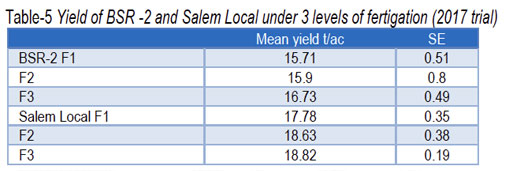
The use of drip –fertigation provided a technical solution whereby nutrients and water can be supplied to the crop with high precision, thereby allowing high nutrient and water –use–efficiencies and high yields. Higher nutrient use efficiency, less water pollution, higher resource conservation, more flexibility in farm operations, efficient delivery of nutrients, healthy crop growth, reduced weeds, reduced soil compaction are the advantages of fertigation [13]. Three years yield data also showed that in general, Salem local maintained its higher yield potential over BSR–2, all through three years of experiment. Salem local is the most popular variety preferred in major turmeric growing states and can be recommended to the farmers.
Research Category: Agronomy, Drip irrigation and fertigation
Abbreviations: RDF: Recommended Dose of fertilizer
Acknowledgement / Funding: Authors are thankful to Research and Development Farm, Jain Irrigation Systems Ltd., Tirupur, Udumalpet, 642154, Tamil Nadu, India.
*Principal Investigator or Chairperson of research: Dr P. Soman
Insisitue: Global Head Agronomy, Department R&D, Jain Irrigation Systems Ltd.,
Tirupur, Udumalpet, 642154, Tamil Nadu, India
Research project name or number: Series on Fertigation studies of crops
Author Contributions: All authors equally contributed.
Author statement: All authors read, reviewed, agreed and approved the final manuscript. Note–All authors agreed that– Written informed consent was obtained from all participants prior to publish / enrolment
Study area / Sample Collection: Jains’ R & D farms, Udumalpet
Cultivar / Variety / Breed name: Turmeric varieties Erode local, Salem local, BSR –2 and Duggirala
Conflict of Interest: None declared
Ethical approval: This article does not contain any studies with human participants or animals performed by any of the authors. Ethical Committee Approval Number: Nil
References
[1] Kandiannan K. and Chandragiri K.K. (2008) Indian J. Horti., 65(2), 209–213.
[2] Solaimalai A., Baskar M., Sadasakthi A., Subburamu K. (2005) Agric.Rev., 1, 1–13.
[3] Rao, M.R. and Rao, D.V.R. (1988) Proc. Natl.Seminar on Chilies, Ginger and Turmeric. Hyderabad, Jan 11–12, 1988.
[4] Archana, H.A. and N.Maragatham (2017) Int. J. Pure and App. Biosci., 5 (5), 649–652.
[5] Rethinam P., Sivaraman K.and Sushma P.K. (1994) Advances in Horticulture vol.9 Plantation and Spice crops. Part 1. Malhotra Publishing house, New Delhi, 477–489.
[6] Agritech.tnau.ac.in
[7] Rajamani K., Shoba N., Velmurugan S., Padmapriya S. and Muthulakshmi P. (2008) Natl.workshop on Zingiberaceae spices. TNAU, Coimbatore, 2008.
[8] Syed Sadarunnisa, C.Madhumati, G.Srinivasa Rao and Srinivasulu B. (2010) J.Hort. Sci., 5(1), 78–80
[9] Velmurugan M., Chezhiyan N., Jawaharlal M., Davamani V. and Vijayaraghavan V. (2008) Agri. Res., 29(3), 220–225.
[10] Rajagopala Reddy A., Tiwari K.N. and Santosh D.T. (2017) Int. J. Pure and App. Biosci., 5(4), 1265–1269.
[11] Thyagarajan G., Vijyakumar M., Selvaraj R.K., Duraiswamy V.K. and Mohd.Yassin M. (2011) Int. J. of Biochromatography, 2(1), 69–71.
[12] Reddy S.S., Angadi S.S. (2014) Res. Environ. Life Sci., 7(4), 237–242
[13] Sathya Priya R., Chinnusamy C., Karthikeyan R. and Kuttimani R.(2017) Int. J. Curr. Microbiol. App. Sci., 6(11) 3215–3230.
Source–Available online at :https://www.bioinfopublication.org/


